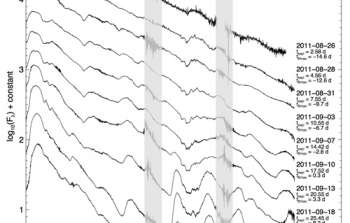sci13012 — Announcement
Surprises from Infrared Supernova Spectroscopy
February 13, 2013
The supernova SN2011fe in M101 continues to develop as an exemplar of Type Ia supernovae, and it still holds surprises. The latest is the detection of unprocessed carbon from the progenitor star in a time series of near-infrared (NIR) spectra. Based on observations using GNIRS on Gemini North, Eric Hsiao (Las Campanas Observatory, Chile) and collaborators suggest that the number of SNe Ia harboring unprocessed carbon from their progenitors may be grossly underestimated based on optical studies alone. They demonstrate that the NIR carbon signature is strongest around the maximum supernova brightness, which makes it a more practical diagnostic than optical signatures, which must be captured before maximum light. A second surprise, comparing more examples, is the lack of correlation between supernova peak luminosity and velocity of ionized magnesium absorption lines. Consequently, previous explanations for the origin of the luminosity-decline rate relationship may not be correct. More information is available in a Gemini web feature and a preprint, in advance of publication in The Astrophysical Journal.
Near-infrared spectra of SN2011fe, offset in flux for clarity and identified by time since maximum. Gray bands mark regions of strong telluric absorption.
About the Announcement
| Id: |
ID
sci13012
|
